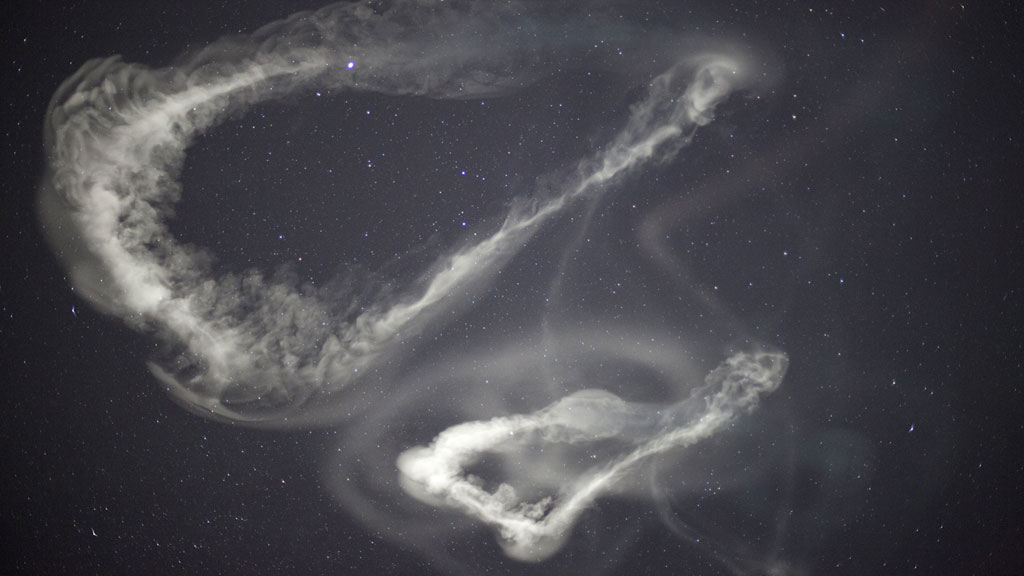NASA Jet Stream Study Lights up Night Sky
High in the sky, 60 to 65 miles above Earth's surface, winds rush through a little understood region of Earth's atmosphere at speeds of 200 to 300 miles per hour. Lower than a typical satellite's orbit, higher than where most planes fly, this upper atmosphere jet stream makes a perfect target for a particular kind of scientific experiment: the sounding rocket. Some 35 to 40 feet long, sounding rockets shoot up into the sky for short journeys of eight to ten minutes, allowing scientists to probe difficult-to-reach layers of the atmosphere.
In March, NASA will launch five such rockets in approximately five minutes to study these high-altitude winds and their intimate connection to the complicated electrical current patterns that surround Earth. First noticed in the 1960s, the winds in this jet stream shouldn't be confused with the lower jet stream located around 30,000 feet, through which passenger jets fly and which is reported in weather forecasts. This rocket experiment is designed to gain a better understanding of the high-altitude winds and help scientists better model the electromagnetic regions of space that can damage man-made satellites and disrupt communications systems. The experiment will also help explain how the effects of atmospheric disturbances in one part of the globe can be transported to other parts of the globe in a mere day or two.
The five sounding rockets, known as the Anomalous Transport Rocket Experiment (ATREX), will launch from NASA's Wallops Flight Facility in Virginia releasing a chemical tracer into the air. The chemical — a substance called trimethyl aluminum — forms milky, white clouds that allow those on the ground to "see" the winds in space and track them with cameras. In addition, two of the rockets will have instrumented payloads to measure pressure and temperature in the atmosphere.
Video of the 5 ATREX sounding rocket launches and the trails of TMA (Trimethylaluminum) that they left in the upper atmosphere.
For complete transcript, click here.

Map of key ATREX locations.

Map of key ATREX locations with trails, but no labels.

Atmosphere chart.

Trimethylaluminum molecule.
In March 2012, NASA Wallops Flight Center is teaming up with Clemson University for the Anomalous Transport Rocket Experiment (ATREX). The experiment consists of launching 5 rockets in about 5 minutes to study the high-altitude jet stream. The rockets will release a tracer that forms a milky, white trail-shaped cloud that will allow scientists to 'see' winds in space. The tracers may be visible from South Carolina to the northeastern States for 20 minutes after launch. The ATREX launch window is March 14 to April 3.
For complete transcript, click here.

Six different still images of the ATREX trails.
Credit: NASA/James Mason-Foley

Still image of ATREX sounding rocket launch.
Credit: NASA/James Mason-Foley

Still image of trails.
Credit: NASA/James Mason-Foley
For More Information
Credits
Please give credit for this item to:
NASA/Goddard Space Flight Center
-
Animators
- Walt Feimer (HTSI)
- Scott Wiessinger (USRA)
- Trent L. Schindler (USRA)
-
Video editor
- Scott Wiessinger (USRA)
-
Narrator
- Scott Wiessinger (USRA)
-
Producer
- Scott Wiessinger (USRA)
-
Scientist
- Miguel Larsen (Clemson University)
-
Writers
- Scott Wiessinger (USRA)
- Karen Fox (ADNET Systems, Inc.)
Release date
This page was originally published on Wednesday, March 7, 2012.
This page was last updated on Wednesday, May 3, 2023 at 1:53 PM EDT.
Series
This page can be found in the following series:Tapes
The media on this page originally appeared on the following tapes:-
ATREX
(ID: 2012024)
Wednesday, March 7, 2012 at 5:00AM
Produced by - Robert Crippen (NASA)

